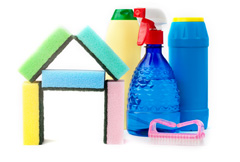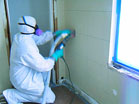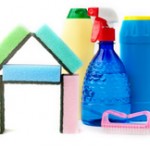Probably the biggest problem being tackled today by your average household – probably student households the most – is mold. It seems to just spring out of nowhere in the areas that one might think are self-cleaning and need somewhat less attention. For example, one of the biggest problem areas for mold is shower sealant, the white stuff between the base of the shower and the walls. Actually this sealant seems to attract mold like no one’s business and as mold thrives in moist conditions it seems hardly surprising that it congregates in bathrooms. But here are a few handy tips and tricks that it might be worth considering the next time you go to tackle it.
 Catch it early: Mold can go from small brown spots to a big black blob quite remarkably fast unless tackled. When it’s at the small brown spots stage then it’s really easy to lift with your average bathroom cleaner and some good old fashioned scrubbing. It’s when it gets to the more difficult later stages that you’ll need to bring in the big guns. So be on the look-out for those small brown dots and bid them farewell before they have time to mature into their problematic black splodge phase.
Catch it early: Mold can go from small brown spots to a big black blob quite remarkably fast unless tackled. When it’s at the small brown spots stage then it’s really easy to lift with your average bathroom cleaner and some good old fashioned scrubbing. It’s when it gets to the more difficult later stages that you’ll need to bring in the big guns. So be on the look-out for those small brown dots and bid them farewell before they have time to mature into their problematic black splodge phase.
Don’t let it start in the first place: Currently, all over the cleaning products aisle, there are plenty of brands bringing out a daily shower cleaner. This is not exclusively for use on showers so is such an easy and convenient way of keeping the mold at bay. After you have showered or bathed then rinse the shower or bath to get rid of lingering soap scum or stray hairs and then spray this cleaner on the surfaces and leave it. That’s it. It’s not an alternative to the full spring clean, which you might be doing fortnightly or so, but it really does keep all that dirt at bay and prevent you from accumulating mold.
Bleach: It’s every cleaner’s dream product and every clothes wearing individuals worst hazard but in the mold stakes it yet again rises to the top. The thing with bleach is that it’s one of those products that seems to work without much help. Certainly with toilets, you leave it for 20 minutes, you flush it and you’re done. With shower mold it’s a fairly similar story – depending how deep it goes. Certainly with a lot of the less deep fungus you pour it around the affected area and leave it and walk away. The warning with this is not to leave it for too long, bleach has corrosive properties – that’s why it cuts through the scum – and you don’t want it corroding the actual sealant. If the mold is deeper, it just means that you have to do the 20 minute bleaching more frequently. You may even want to rub it in with a cloth so that you can be sure none of it is getting away in the 20 minutes you leave it to work its magic.
So, a few tips and tricks that might make the problem of mold slightly less problematic. Hopefully these will be helpful.
Stella Benett is a 32 years old passionate blogger and freelancer but before all she is a lovely mother and wife. As every housewife Stella has no free time and often does a lot of things at the same time. She loves cleaning her house in Hemel Hempstead because it gives her a sense of ‘pleasure’ and ‘achievement’.



